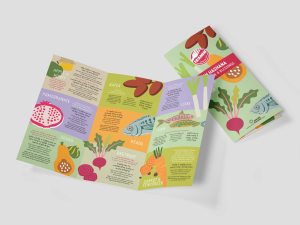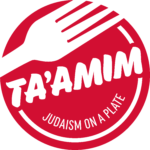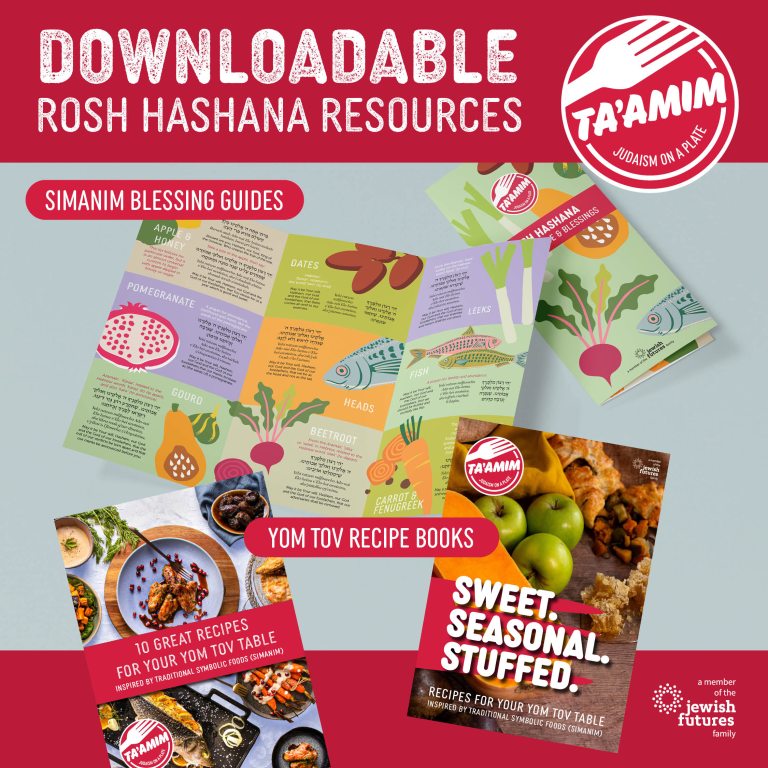Signs of Intention: The Simanim of Rosh Hashanah
Each Rosh Hashanah is an opportunity to pause, take stock, and step forward with resolve and purpose into a new year. It is a season for connection: with Hashem, as we pray for a sweet and good year ahead; with loved ones, as we gather around festive tables laden with meaning; and with ourselves, as we reflect on where we’ve been and who we hope to become. And, at this poignant threshold, our foods become vessels of intention; sweetness carries significance, taste transforms into prayer, and we begin our festive meals with symbolic foods.
These meaningful morsels are known as simanim, meaning ‘signs’, ‘omens’ or ‘symbols’, and they’ve graced Jewish tables for centuries. Referred to in the Talmud, the simanim invite us to speak our hopes aloud and infuse the year’s beginning with purpose. Where Rosh Hashanah once included sacrificial offerings in the Temple, today we offer words, our prayers and intentions, in their place. The simanim give us a way to express our wishes with our whole selves: body, mouth, and mind aligned in blessing. With each bite, we utter a Yehi Ratzon (“May it be Your will”), a short blessing, asking for divine kindness in the year to come. What results is a ritual we feel with all our senses.
The simanim as we know them today trace their roots to the teachings of Abaye, a Talmudic sage who encouraged the use of symbolic foods at the start of the year. Mentioned in Horayot 12a, these included leeks, beets, dates, and gourds—each tied to a hopeful play on words. Over time, these small acts of intention took root in Jewish homes across the world. They hold space for both joy and sorrow, for laughter and longing, for past and future—all within a single bite.
Some communities, particularly those of Sephardi and Mizrahi heritage, developed what might be called a Simanim Seder—an ordered, multi-course ritual meal complete with liturgy, family participation, and a variety of symbolic dishes. A Persian Jewish table might feature spinach and quince; Syrian Jews might include pumpkin. In Iraqi homes, black-eyed peas (lubiya) are a mainstay, possibly due to a case of mistaken identity. Food historian Gil Marks notes that in the Middle Ages, the Arabic word lubiya was confused with the Aramaic rubiya, meaning fenugreek. Rubiya, in turn, shares a root with the Hebrew word yirbu, meaning ‘increase’ or ‘multiply’, making it a fitting siman for abundance.
Ashkenazi households have typically taken a more modest approach; apples dipped in honey are the best-known custom, alongside carrots (whose Yiddish name, mehren, is a homophone with the word for ‘increase’). While fewer simanim might appear, the intention remains intact: to greet the new year not just with sweetness, but with mindfulness.
Each symbolic food becomes a miniature prayer. We don’t just hope silently; we articulate. We taste. We chew with awareness. In this way, the simanim become a spiritual practice grounded in the everyday. They root us in the moment, even as they carry us forward into the unknown. It is a reminder that authentic connection and meaningful prayer is not reserved for the synagogue or the scroll. It can live in a spoonful of pomegranate seeds, in the shared laughter over a pun, (I’ve heard of people eating raisins and celery, hoping for ‘a raise in salary’), or in the pause before a bite.
While many of the simanim are accompanied by light-hearted prayers for a sweet year, or an increase in our merits, some contain a striking gravity. Over leeks, we say: “May it be Your will that our enemies be cut off.” Over beets: “May our adversaries be removed.” Over dates: “May those who hate us be consumed.” These are not casual wishes. They are ancient words voiced anew, echoing the fears and longings of generations. In the wake of October 7, these blessings feel particularly relevant. Eating a date while praying for the downfall of kidnappers, murderers and regimes bent on our destruction is both earnest and understandable. There is something deeply empowering about giving voice to our hopes, no matter how fragile, through a ritual so accessible and human.
What’s striking is how universal this custom has become, despite the differences in language, culture, and cuisine. Whether it’s a Moroccan platter laden with fried delicacies or a quiet meal with apple slices and honey cake, Jews the world over gather around their tables to engage in this shared expression of our deepest yearnings. It is a reminder that we are a people united not only by texts or land, but by the rhythms of our rituals, the way we infuse life with meaning through the simplest of acts. We whisper with prayerful intention, taste sweetness, and trust that even the smallest signs can ripple outward into something vast.
So, whether your table holds two simanim or twenty, may each one reflect not just what you hope for, but who you are becoming.
Wishing you a year of sweetness, of strength, and of deeply felt connection.
Download our Simanim Blessings roll-fold crib sheet

More Downloadable Rosh Hashana Resources
Ta’amim are delighted to make both of our seasonal recipe books for the High Holy Days available for download, featuring food inspired by sweet, seasonal, stuffed foods and the Simanim, the significant foods eaten at Rosh Hashana and throughout the month of Tishrei as signifiers and good omens for a sweet, abundant, fruitful year ahead. These recipe booklets are packed with tasty, simple, showstopping dishes to elevate your Yom Tov table over Rosh Hashana, Sukkot and Simchat Torah, as well as food for thought to share with your guests as you ruminate.
Delectable starters include twists on traditional dishes such as our Sweet and Sour Fish Tacos and Spiced Honey Halloumi Teiglach, as well as ever-popular crowd-pleasers including Harissa Honey Brisket Pockets and Marmalade Chicken Pancakes.
Featured mains from Lamb Tagine and Sticky Date and Pomegranate Ribs, to Stuffed Courgettes and even Spinach and Leek Tagliatelle allow the Simanim and seasonal ingredients to shine.
Fun, festive desserts including Caramelised Apples with Honeycomb Ice Cream and indulgent Honey Bourbon Tiramisu sit alongside healthier sweet treats in the form of Apple, Carrot and Beetroot Muffins.
These and many more can be found in our two recipe books, available to download now.
Chag Sameach. Wishing you and yours a very happy, healthy, sweet and peaceful new year.
Shana Tova U’metuka from all of us at Ta’amim.

 Sweet. Seasonal. Stuffed. – Download Here.
Sweet. Seasonal. Stuffed. – Download Here.

Images by Sophy Weiss Photography, Yaffa Judah Photography and Ta’amim


